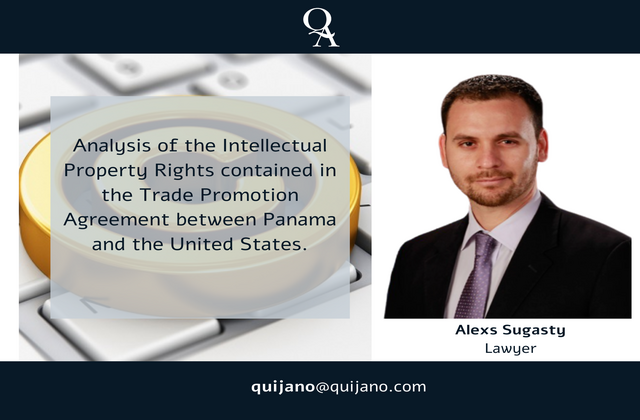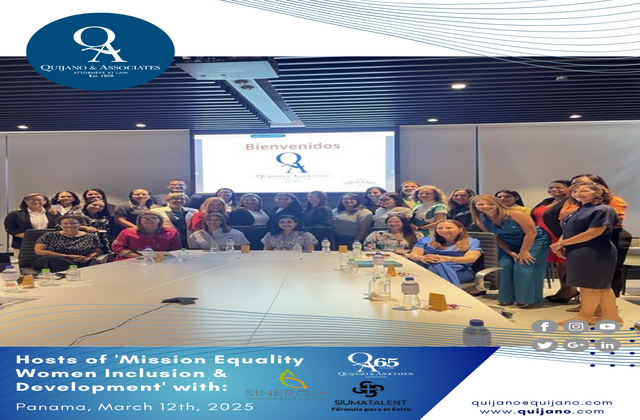Analysis of the Intellectual Property Rights contained in the Trade Promotion Agreement between Panama and the United States

- INTRODUCTION
It is interesting to begin this research work by clarifying that the relationship between Panama and the United States is not a recent one. The United States has been collaborating with Panama for years promoting economic, political, security and social development through international agencies. Among others, Panama has entered into agreements with the United States on maritime law enforcement, the fight against terrorism, drug trafficking, vehicle theft, and the well-known Free Trade Agreement.
In the economic field, Panama has been successful in the enforcement of Intellectual Property rights, in which it has currently signed a Bilateral Investment Treaty with the United States and an agreement with the Overseas Private Investment Cooperation.
The Trade Promotion Agreement, in general, seeks to consolidate free access for a large percentage of Panama’s exports to the United States, eliminating the rest of the custom duties progressively. In this sense, a Bilateral Free Trade Zone was established, eliminating custom duties on the vast majority of products as long as they comply with the rules of origin established in the Agreement and in the regulations in force.
Said Agreement became law on October 21, 2011 and entered into force in both the United States and Panama on October 31, 2012. Basically, this agreement maintains similar guidelines to those already perfected in the World Trade Organization (WTO), as well as in other international agreements and commitments, allowing the rules governing investment, Intellectual Property rights, labor, environment, and government procurement to be further strengthened and seeking equity and benefits for the signatory countries.
2. GENERAL CONSIDERATIONS
he Trade Promotion Agreement is an economic and social development tool used to facilitate trade and investment between one or more countries. They guarantee the easier entry of our products to other countries without having to pay the taxes that are imposed and charged for the introduction of goods into the territory of the signatory countries.
The trade promotion agreements have proven to be tools that contribute to the economic awakening and development of communities, based on the real advantages they generate. The special situation or scenario generated by these trade promotion agreements attracts new investments from businessmen who wish to produce and provide services in Panama, taking advantage of the benefits of a Trade Promotion Agreement with one of the most powerful economies in the world.
The Trade Promotion Agreement entered into between Panama and the United States aims to create a broader and safer market for goods and services in their respective territories, while recognizing the differences in the levels of development and size of the economies of both countries, so that the rules are established in a clear and concise manner for mutual benefit and thus the trade exchange is carried out in the best way, contributing to the development and expansion of world trade, and continue to promote regional economic integration.
In general, Trade Promotion Agreements are entered into with the idea of establishing agreements for the programmed liberalization of trade in goods between the signatory countries. As historic trading partners, Panama and the United States are seeking to strengthen and increase trade relations between the two countries.
Unlike previous agreements, the Panama – United States TPA not only regulates the exchange of goods, but also expands and includes trade in services and investments. Additionally, it addresses other trade-related issues such as intellectual property, government procurement (introducing a chapter on government procurement that the General Law of Public Procurement of Panama has added in its text to generate asymmetry between domestic and international standards such as this TPA), labor issues, cooperation, dispute settlement and environmental issues that are related to trade activity.
3. INTELECTUAL PROPERTY RIGHTS IN THE TPA BETWEEN PANAMA – USA
Without ignoring those intellectual developers, stimulating creativity and innovation, promoting trade in goods and services that are subject to intellectual property rights. And, it is here, where we are going to stop to analyze a little more in depth about the commitments that the Republic of Panama acquired in the matter of Copyright, in Chapter 15 of the Trade Promotion Agreement with the United States.
This chapter promotes the protection of those intangible goods that involve an intellectual effort of their creators, regardless of whether they are natural persons or legal entities, thus regulating the aspects of the rights of the creator or inventor that have a relevant impact on trade. It includes provisions on trademark protection, copyright obligations, among others. It also establishes mechanisms for possible disputes regarding the adoption of legislation on Intellectual Property.
In a good manner, Panama managed to meet deadlines for adhesion to some administrative conventions by the World Intellectual Property Organization, for example, in the Trademark Law Treaty on trademarks, it was achieved in 2011, in the International Convention for the Protection of New Varieties of Plants, Panama achieved a period until 2010.
Article 15.5 of this TPA, establishes the obligations relevant to Copyright and Related Rights, ensuring the right of authors and related rights, meaning artists, performers, producers, etc., to authorize or prohibit all reproduction, provided that the exceptions contemplated in the Berne Convention apply with respect to all material that is digital or electronic.
In this way, said Treaty contemplates the legal tools for those Copyrights and Related Rights that feel that the agreements have not been respected by one of the parties, in order to provide legal protection, making available technological measures, that is to say, technology that in the normal course of its operation controls the access to a work, or that protects any copyright or right related to copyright, mechanisms and legal remedies for those who evade the measures contemplated in both the Copyright Treaty of the World Intellectual Property Organization and in the Trade Promotion Agreement.
Consequently, this chapter also establishes the application of criminal measures and sanctions against those who fraudulently alter the information on the management of rights or who make the material available to third parties knowing that such management has been altered without the necessary authorization. Therefore, neither is it authorized to transmit television signals on the Internet without the authorization of the owner of the content.
Regarding the specific obligations to the Copyrights, it is the Authors of their creations who will allow or not the reproduction of their works, either by the electronic means they wish, so that it is the viewer who decides where he/she wishes to take advantage of such creation.
With respect to the obligations specific to Related Rights, this article states that the rights and obligations must be applied to those already established in the Rome Convention, conferring the exclusive right over their creations, interpretations, performances, and unfixed productions.
Therefore, we understand that both parties must fully follow the procedures in the Trade Promotion Agreement, requiring the remedies set forth in this Article in order to respect the rights of authors and thus giving them the assurance that their creations are well protected and thus encouraging them to continue promoting their inventions and expand in national and international trade.
Chapter 15 makes it clear that both the procedures and the resources for the care and attention of Intellectual Property rights, including Copyrights, are established in accordance with the principles of due process that each party recognizes and according to the legal foundations of each party’s own system; however, it does not oblige the implementation of a specialized governing body or a judicial system different from the one already in place for the enforcement of intellectual property rights.
Therefore, by way of summary, we can conclude that this chapter indicates that the parties must foresee the fact and evidence that, in a certain case, an action or chain of events infringes any of the established provisions, and that such actions and evidence are brought to the attention of a Judge who must sanction and/or order the payment of an indemnity to compensate the damages suffered by the owner of the work, creation, or invention. In Panama, it is of popular knowledge that there are sanctions in the Penal Code for those who violate against Industrial Property Rights, to such an extent that it establishes the deprivation of freedom as one of them, but both for the registration of a trademark, patent or to successfully file a claim for copyright violations, the owner must hire the services and legal advice of a suitable lawyer, for which Quijano & Asociados is a forensic firm that has a lot of experience in these topics.
4. CONCLUSIONS
- The study of Intellectual Property aims to protect those creations that entail an intellectual effort on the part of the creators or inventors, regulating their rights in a more suitable way so that their expansion in the commercial world can take place in an orderly and protected manner.
- Both in the case of Copyright and Related Rights, the owners have the exclusive right to authorize or not the communication to the public of their works.
- The Trade Promotion Agreement between Panama and the United States has certainly generated benefits and improvements in intellectual property, public contracting, and other matters.
- Whether for the registration of a trademark, patent or to successfully file a claim for copyright infringement, the owner must hire the services and legal advice of a suitable lawyer, for which Quijano & Asociados is a forensic firm that has a lot of experience in these topics.




